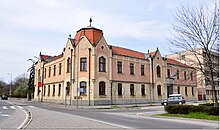Dunajská Streda
| Dunajská Streda | ||
|---|---|---|
| coat of arms | map | |

|
|
|
| Basic data | ||
| State : | Slovakia | |
| Kraj : | Trnavský kraj | |
| Okres : | Dunajská Streda | |
| Region : | Podunajsko | |
| Area : | 31.451 km² | |
| Residents : | 22,684 (Dec. 31, 2019) | |
| Population density : | 721 inhabitants per km² | |
| Height : | 118 m nm | |
| Postal code : | 929 01 | |
| Telephone code : | 031 | |
| Geographic location : | 48 ° 0 ′ N , 17 ° 37 ′ E | |
| License plate : | DS | |
| Kód obce : | 501433 | |
| structure | ||
| Community type : | city | |
| Urban area structure: | 3 districts | |
| Administration (as of November 2018) | ||
| Mayor : | Zoltán Hájos | |
| Address: | Mestský úrad Dunajská Streda Hlavná 50/16 92901 Dunajská Streda |
|
| Website: | www.dunstreda.sk | |
| Statistics information on statistics.sk | ||
Dunajská Streda (German very rarely Niedermarkt ; Hungarian Dunaszerdahely ; Hebrew סרדאהלי) is a city in southern Slovakia in the heart of the Schüttinsel . It is the capital of the district of the same name .
The place is mostly inhabited by Hungarians (16,752 people according to the 2011 census) and is the most important center of the Hungarian minority in Slovakia .
history
The city was built on the site of an ancient settlement . A Slavic / Slovak burial site was found from the time of Great Moravia .
The first sources are from 1250 and 1254–1255. At that time the place was owned by the Pressburg Castle , later owned by the Pressburg manor. Dunajská Streda has been the economic and commercial center of the Schüttinsel since the 15th century, and then a city (town and market rights) since the 16th century.
Many Jewish merchants settled here at the end of the 18th century . In the 19th century and the first half of the 20th century, the city was an agricultural settlement with high unemployment.
In 1930 there were 2,944 Hungarians, 2,186 Jews, 503 Slovaks and 73 Germans living in the city. After the Second World War, the city became an industrial location (sugar, canned food, precast concrete parts).
It belonged to the Kingdom of Hungary until 1918 and then came to the newly formed Czechoslovakia . The city came back to Hungary from 1938 to 1945 through the First Vienna Arbitration .
After 1945, part of the Hungarian population was largely exchanged for Hungarian Slovaks as part of a population exchange with Hungary. The Jewish population (2000-3000 people) disappeared completely during the Second World War. Dunajská Streda is now inhabited by around 3500 Slovaks.
The present-day town is incorporated into the previously independent municipalities Stredská Nová Ves / Szerdahely-Újfalu , Felserská Nová Ves / Félszer-Újfalu , Bašatejed / Bassa-Tejed (incorporated at the beginning of the 19th century), Nemešseg / Nemesszeg (incorporated around 18 ) , Elötejed (after 1863), Malé Blahovo (1960) and Mliečany (1960) to the place Dunajská Streda (Hungarian [Duna-] Szerdahely ).
Surname
The town got its Hungarian name (1250 (maybe) Zerda , 1254 Svridahel , 1786 Serdahely ) thanks to the privilege of organizing a market every Wednesday (Hungarian szerda , Slovak streda ). Hely means "place", "place". Szerdahely means something like "place where a market takes place on Wednesdays" (compare for example the Hungarian name of Trnava ). Since there were or are four other places with the name Szerdahely / Streda in Slovakia, the attribute “Danube” (Hungarian Duna , Slovak Dunajská ) was added in the 19th century .
Because of the high proportion of the Hungarian population, the official use of the Slovak name is only proven in 1919 (the emergence of Czechoslovakia ).
Attractions
In the Nová Ves / Újfalu district, in the 18th and 19th Typical palaces built in the 19th century, especially:
- Biely kaštieľ (White Castle) - a late Classicist building, late 19th century (it no longer exists today)
- Žltý kaštieľ (Yellow Castle) - Baroque style , early 18th century
The Roman Catholic Church is mentioned for the first time in 1341, the Evangelical Church was built in 1883.
The synagogue was built in 1870, but it was destroyed by a bomb hit in 1945.
A casino was built in the popular restaurant Zöldfakoszorú in 1860 . Various cultural events were organized in this casino, for example theater . The casino library contained 1,500 books . However, in 1919 the casino was closed and the books were lost.
City structure
- Dunajská Streda (Hungarian Dunaszerdahely )
- Malé Blahovo (Hungarian Síkabony , formerly Kisabony )
- Mliečany (Hungarian Ollétejed )
Twin cities
- Subotica , Serbia
- Gödöllő , Hungary
- Odorheiu Secuiesc , Romania
- Senta , Serbia
- Győr , Hungary
- Jimbolia , Romania
- Berehove , Ukraine
- Dalaman , Turkey
sons and daughters of the town
- Hermann Vámbéry (1832–1913), Hungarian orientalist
- Herman Steiner (1905–1955), American-Hungarian chess player
- Andrew Steiner (1908–2009), Czechoslovak-American architect
- Imrich Bugár (* 1955), discus thrower, won silver at the 1980 Olympic Games
- József Nagy (* 1968), politician
- Balázs Borbély (* 1979), football player
- Ján Ďurica (* 1981), football player
- Alexandra Bíróová (* 1991), football player
- Tibor Linka (* 1995), Slovak canoeist
- László Bénes (born 1997), football player




